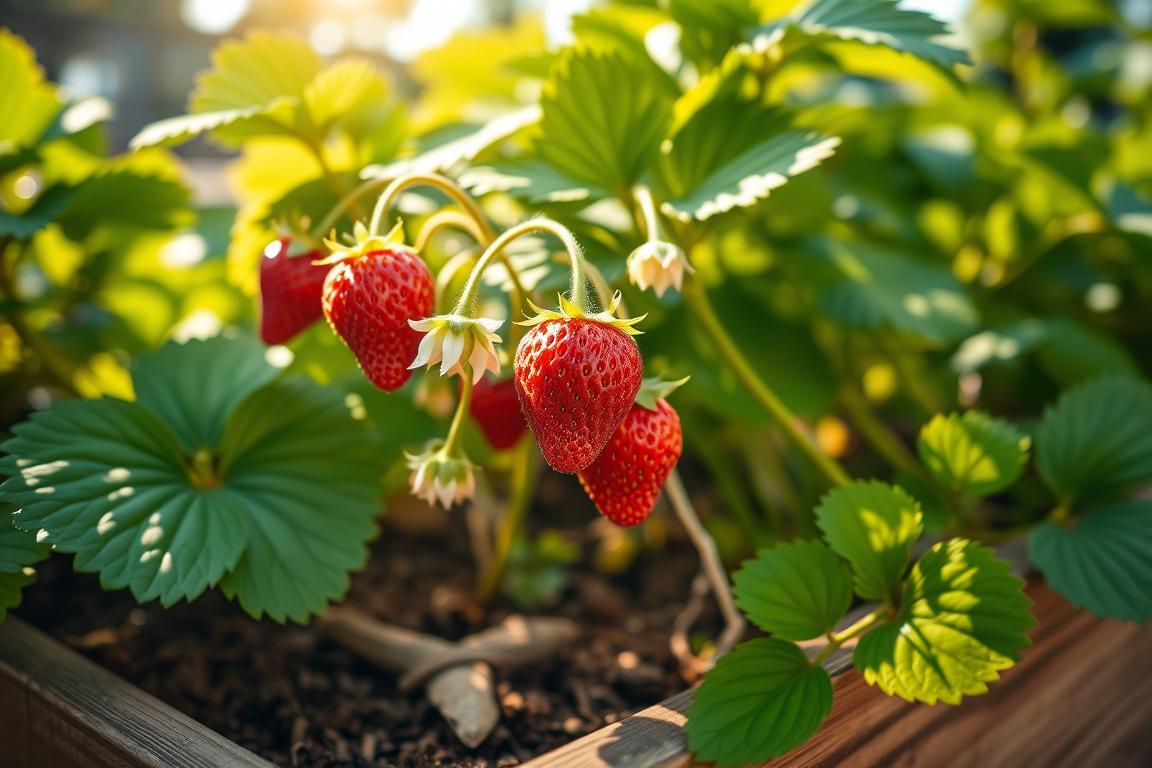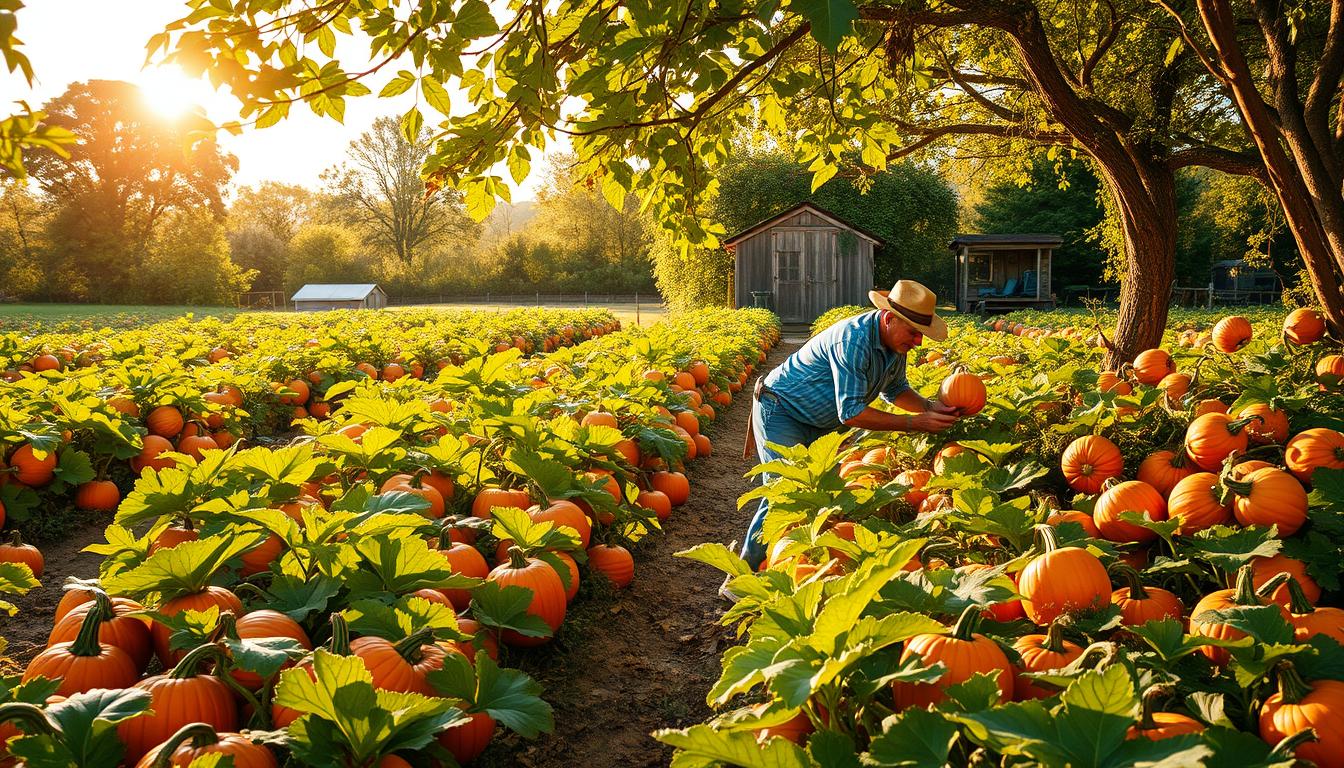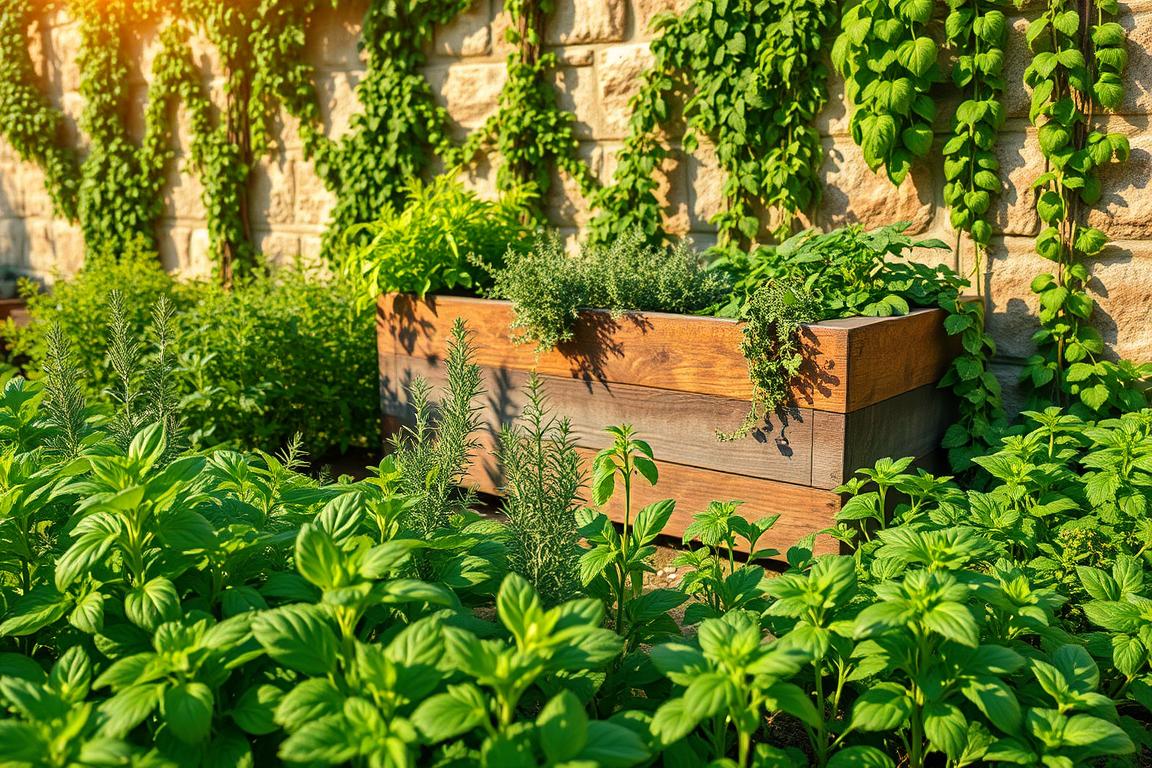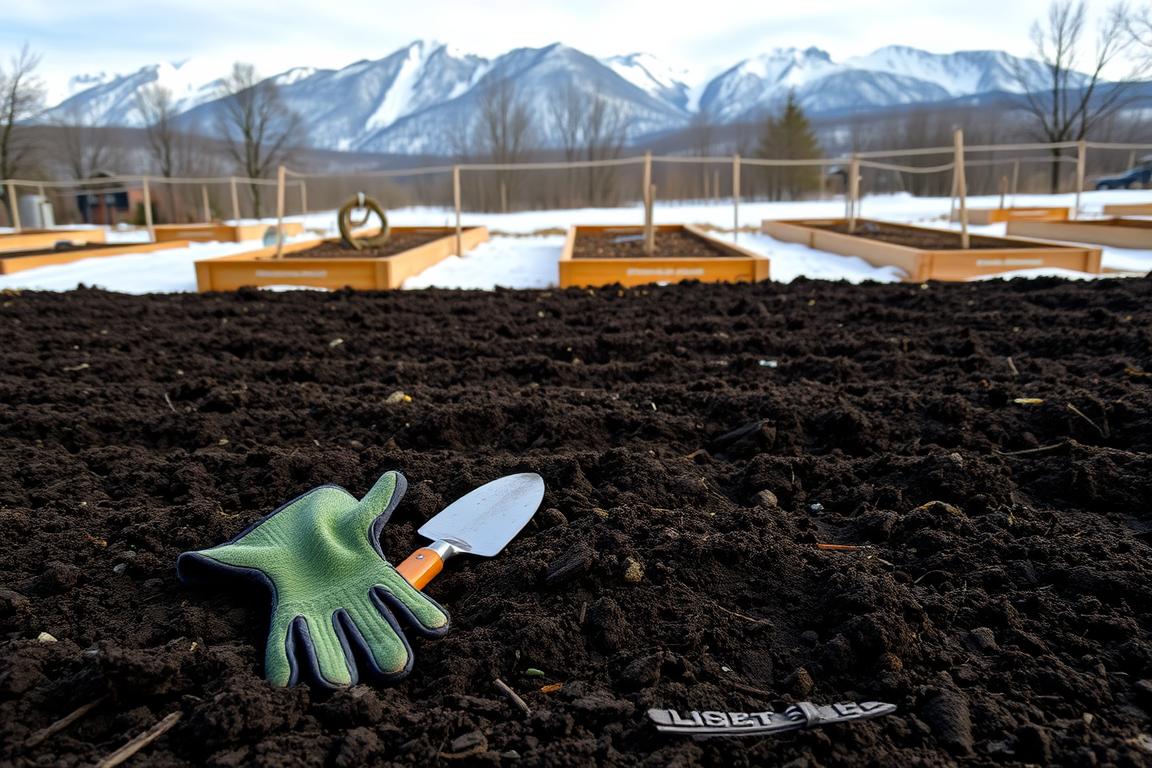I love growing strawberries at home because they’re easy to cultivate and provide a rewarding harvest. With the right techniques, you can enjoy fresh strawberries right in your own backyard.
Strawberries are a great addition to any home garden, thriving in various conditions. To achieve success, it’s essential to follow best practices for strawberry cultivation.
Key Takeaways
- Choose a sunny location for your strawberry patch
- Use well-draining soil to prevent waterlogged roots
- Water strawberries regularly, but avoid overwatering
- Fertilize your strawberries during the growing season
- Keep your strawberry patch free of weeds
Understanding Strawberry Varieties and Site Selection
Starting a strawberry garden means knowing the different types and where to plant them. There are many strawberry varieties to pick from. The right choice can make a big difference in your harvest.
Popular Strawberry Varieties for Home Gardens
There are three main types of strawberries: summer-fruiting, perpetual, and alpine. Summer-fruiting strawberries give one big crop in summer. Perpetual strawberries produce smaller crops all season. Alpine strawberries are small but very tasty and great for containers. Choosing the right variety depends on your desired harvest period and climate.
For home gardens, ‘Everbearing’ and ‘Albion’ are favorites. They produce a lot and are resistant to diseases. ‘Albion’ is known for its big, sweet berries.
Choosing the Perfect Location for Your Strawberry Patch
Finding the right spot is key for growing strawberries. They need full sun to grow well. So, pick a spot that gets at least 6 hours of direct sunlight. The area should also drain well, as strawberries can get root rot in wet soil.
The soil should be rich in organic matter. Adding compost or well-rotted manure can make the soil better for strawberries. This creates a great place for your strawberries to grow.
When to Plant Strawberries in Different US Climate Zones
The best time to plant strawberries changes with the climate. In cooler areas (USDA zones 3-5), spring is best. This lets them grow before summer gets too hot. In warmer areas (USDA zones 6-8), fall planting works well. It helps them grow before the next summer.
In places with mild winters, you can plant strawberries in late winter to early spring. Knowing your local climate zone helps figure out the best planting time.
Soil Preparation and Essential Growing Strawberrys Requirements
Starting a strawberry patch right is key. Strawberries can grow in many places, but the right soil is essential for the best harvest.
Creating the Ideal Soil Mix for Maximum Yield
For strawberries, the soil needs to drain well and be rich in organic matter. A mix with lots of compost or manure is best. It makes the soil fertile and helps it hold water and air better.
Adding a 2-inch layer of compost or manure to the top 6-8 inches of soil is a good idea. It gives strawberries the nutrients they need to grow.
Optimal pH Levels and Nutrient Requirements
Strawberries like slightly acidic soil, with a pH of 5.5 to 6.8. Keeping the pH right helps them absorb nutrients and stay healthy. They need nitrogen, phosphorus, and potassium to grow well.
Testing your soil can show its pH and nutrient levels. Then, you can adjust it to meet strawberry needs.
Container vs. Ground Planting Methods
Strawberries can grow in containers or directly in the ground. Each way has its own benefits and challenges.
| Characteristics | Container Planting | Ground Planting |
|---|---|---|
| Soil Control | Easy to control soil mix and pH | More challenging to control soil conditions |
| Space Requirements | Flexible, can be placed in small spaces | Requires a dedicated garden bed |
| Watering Needs | Containers dry out faster, requiring more frequent watering | Ground soil retains moisture longer |
Choosing between containers and the ground depends on your garden and what you like.
Planting and Maintenance Techniques
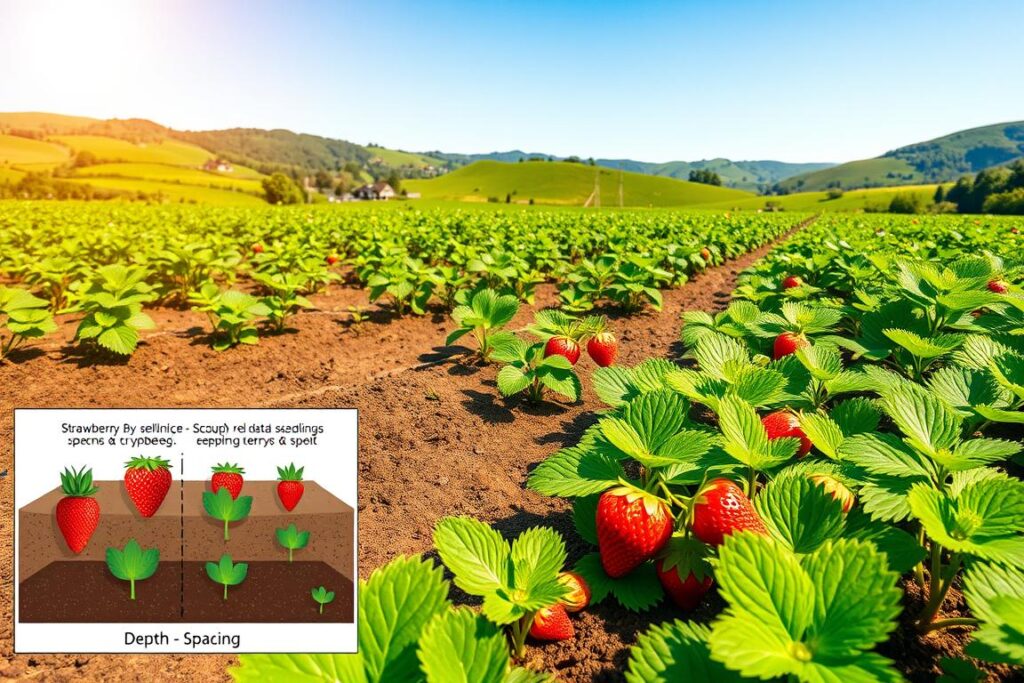
The journey to a bountiful strawberry harvest starts with proper planting and care. To grow a healthy strawberry patch, follow a detailed guide. It should cover planting, watering, fertilizing, and mulching.
Step-by-Step Planting Guide for Beginners
Planting strawberries correctly is key to a successful harvest. Choose a spot with full sun and well-draining soil. Space strawberry plants about 12-18 inches apart, depending on the variety.
Dig a hole that’s 6-8 inches deep. Gently spread the roots out. Cover the roots with soil, making sure the crown is level. Water thoroughly after planting.
Watering and Fertilizing Schedule Throughout the Season
Keeping a consistent watering schedule is vital for strawberry plants. Water them regularly, keeping the soil moist but not waterlogged. For fertilizing, use a balanced fertilizer in early spring and again after the harvest.
Follow the manufacturer’s instructions for application rates to avoid over-fertilizing.
Mulching and Weed Control Strategies
Mulching helps retain moisture, suppress weeds, and regulate soil temperature. Organic mulching options like straw, bark chips, or pine straw are good for strawberries.
Organic Mulching Options
When choosing organic mulch, pick materials that are easy to find and affordable. Straw is a popular choice because it’s lightweight and easy to apply. Apply a 2-3 inch layer of mulch around your strawberry plants, keeping it a few inches away from the plant crown.
Effective weed control is also crucial. Regularly remove weeds by hand or with a tool, being careful not to damage the strawberry roots. By combining mulching with regular weeding, you can significantly reduce competition for water and nutrients.
Preventing and Treating Common Strawberry Problems
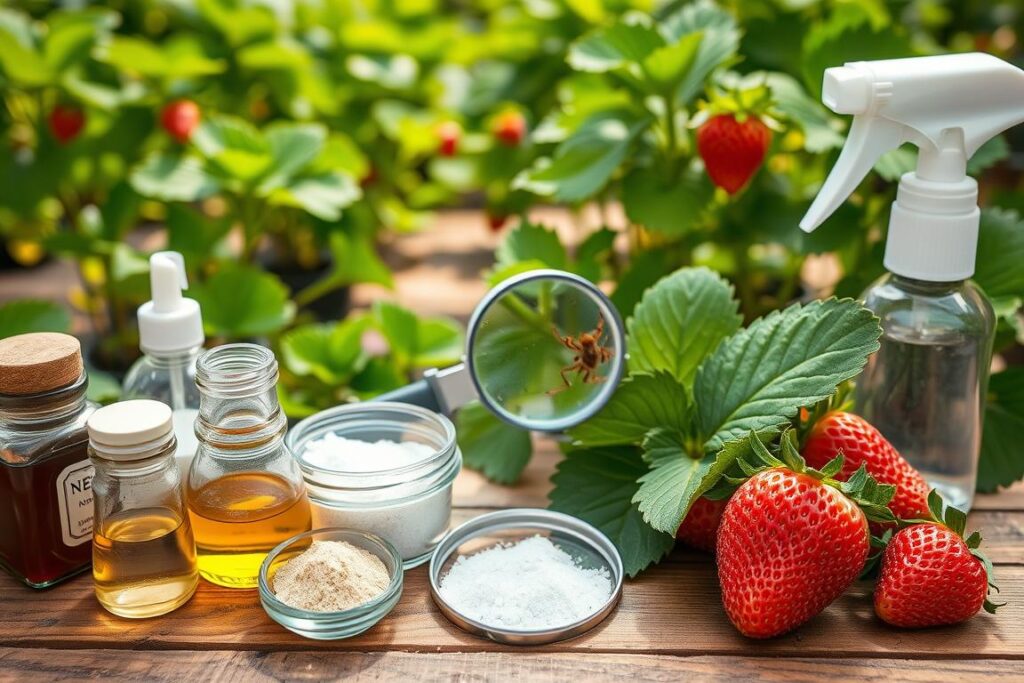
Getting a good strawberry harvest starts with spotting and fixing common issues early. Growers often deal with pests and diseases that hurt their yield.
Identifying and Managing Pests Naturally
Pests like slugs, birds, and aphids can harm strawberries. To fight these pests naturally, you can try a few things. For instance, introducing beneficial insects or using barriers to protect your plants is effective.
Recognizing and Treating Diseases
Strawberries can get sick with gray mold and leaf spot. Spotting the signs early is key to treating them well. Using organic fungicides and keeping plants well-ventilated can help fight these diseases.
Propagation and Runner Management
Good propagation and runner management keep strawberry plants healthy. Cutting off extra runners helps the plant focus on growing fruit. This boosts your harvest.
Conclusion: Harvesting and Enjoying Your Homegrown Strawberries
The moment of truth arrives when your strawberries are bright red and ready to harvest. Regular picking encourages the plants to continue producing fruit, so be sure to check your patch frequently.
When harvesting strawberries, gently grasp the fruit and twist it off the stem to avoid damaging the plant. Enjoying homegrown strawberries is a delight, whether you savor them fresh, add them to salads, or use them in baked goods.
Mastering strawberry harvesting techniques is the final step in growing delicious strawberries. By following the tips outlined in this article, you’ll be able to enjoy a bountiful harvest and make the most of your homegrown strawberries.
FAQ
What are the best strawberry varieties for home gardens?
For home gardens, ‘Albion’, ‘Camarosa’, and ‘Seascape’ are top picks. They offer high yields and fight off diseases well. Choose varieties that match your climate and maintenance level.
How much sunlight do strawberries need to grow?
Strawberries need at least 6 hours of direct sunlight daily. I pick a spot that gets lots of sun for my strawberry patch.
What is the ideal soil pH for growing strawberries?
Strawberries thrive in soil with a pH of 5.5 to 6.5. I test my soil often and add compost if it’s off.
Can I grow strawberries in containers?
Yes, growing strawberries in containers works well. It lets you control soil and drainage, perfect for small spaces. Containers should be 6-8 inches deep for the roots.
How often should I water my strawberry plants?
Strawberries need steady moisture, more when they’re fruiting. I water them 1-2 inches weekly, either from rain or irrigation. Make sure the soil drains well to avoid waterlogging.
What are some common pests that affect strawberry plants, and how can I control them naturally?
Aphids, slugs, and snails are common pests. I use neem oil, diatomaceous earth, or introduce ladybugs to keep them away naturally.
How do I propagate new strawberry plants?
You can start new plants by dividing or using runners. I separate runners and pot them up in a mix that drains well.
When is the best time to harvest strawberries?
Harvest strawberries when they’re bright red and slightly soft. I pick them in the morning, after the dew, for the sweetest taste.
Can I grow strawberries using organic farming methods?
Yes, you can grow strawberries organically. I use natural pest control, compost, and well-rotted manure for healthy growth.
How can I prevent strawberry diseases like powdery mildew and botrytis?
To prevent diseases, ensure good air flow and remove infected parts. I also use organic fungicides as needed. Regular checks and quick action stop disease spread.


